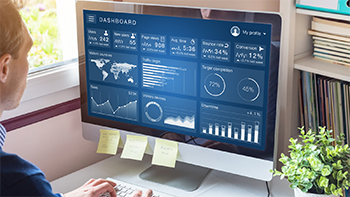Table of Contents

When running a B2B eCommerce store, there is no end to the eCommerce metrics and KPIs you could monitor and optimize for. Between the store, database, and analytics services, there are so many ways to slice the raw data, but your ability to measure your store’s performance doesn’t mean you should measure everything. Focusing your efforts and resources on the wrong B2B eCommerce metrics can be a waste of time and money, and could also negatively impact the profitability of your business.
So which B2B eCommerce metrics should you focus on and optimize for? The answer depends on the type of business you run and what specific goals you’re trying to achieve. For example, important B2B metrics are going to be different between startups and mature companies, and they’re also going to differ among industries. Nevertheless, some B2B eCommerce metrics are worth keeping an eye on regardless of company specifications.
What are B2B eCommerce KPIs and Why Do They Matter?
Starting at the very beginning, a metric is a measurement that captures a quantifiable activity of your eCommerce store’s performance. For example, the number of people who visit your store in a month is a metric. Metrics not only include the information you are interested in, but they also help you keep your thumb on the pulse of your business’s profitability.
Over time, changes in B2B eCommerce metrics show whether the growth of your store is moving in the right direction; if you made changes to your business during a certain time period in an attempt to attract more visitors, your metrics can help you understand whether those changes had a positive impact on your customers.
A performance-related question that many business owners have is – is a metric the same as a key performance indicator (KPI)? They are related, and the terms are often used interchangeably, but a B2B eCommerce KPI is more specific. As we said, there are dozens of possible metrics you could measure, but only a subset of them are important for your business and its current plans. These are the KPIs – the metrics that matter.
If you’re investing significant marketing dollars to increase traffic to your store, then the number of visitors is a KPI. If, in contrast, you’re more focused on growing each sale’s size, that is a KPI, while the total number of visitors may be less critical but supporting metric.
The 5 Most Important B2B eCommerce Metrics
While the most important B2B eCommerce metrics change depending on the business’s objectives, there are a handful of metrics and KPIs that can reliably track the success of any B2B eCommerce venture.
1. Customer Acquisition Cost
Customer acquisition cost (CAC) is the amount you spend to acquire customers divided by the number of customers acquired in a given period. It’s an average that helps you figure out how much of your marketing and sales budget is spent on each new customer. It’s often used alongside a customer lifetime value metric to calculate whether you’re spending more to acquire customers than you make from them over the long-term.
2. Customer Retention Rate
Customer retention rate (CRR) measures the proportion of buyers who purchased within a specified timeframe. Or, to put it another way, it indicates how many of your past buyers are still buying from you. CRR is the opposite of churn rate, which measures how many buyers you lost in a given period.
To calculate CRR:
- Take the number of customers you have at the end of a period.
- Subtract the number of new customers acquired during the period.
- Divide by the number of customers you had at the beginning of the period.
- Multiply by 100.
The result is a percentage representing retained customers.
Customer retention is important for several reasons. Acquiring new customers is more expensive than serving existing customers, so it’s better to keep those you have. Perhaps more consequential, if customer retention rates are low, it indicates dissatisfaction with some aspect of your business, store, or products.
3. Average Order Value
Average order value (AOV) is straightforward: it’s the total value of orders divided by the number of orders. As a general rule, you should hope for increases in AOV because it’s directly related to revenue. Declining AOV indicates that customers are less happy with your product range and store than they once were.
4. Online Order Frequency
Online order frequency (OOV) answers the following question: How often do buyers purchase directly from the eCommerce store versus another digital channel such as a PunchOut catalog-equipped eProcurement platform?
Measuring online order frequency is critical if your business recently adopted eCommerce. Low or declining online order frequencies can indicate buyers prefer traditional—and more costly—sales channels, or that they would prefer an eCommerce experience that is integrated with their procurement/spend management systems and strategies.
5. Percentage of Return Visits
When B2B businesses first launch an eCommerce website, they may find it difficult to transition buyers who are more familiar with traditional in-person or phone sales. The percentage of return visits indicates how “sticky” the eCommerce experience is. If buyers try it once and revert to their previous behavior, there are a couple of possible causes:
- They may simply prefer the way orders were done before, in which case, you may want to double down on your efforts to educate them about the benefits of buying online.
- They may find that your store is lacking in functionality or user experience, as many B2B buyers prefer eCommerce stores that are integrated into their eProcurement system to enable automation features such as PunchOut catalogs and purchase order automation.
TradeCentric empowers suppliers to integrate their stores with buyer eProcurement systems, improving the B2B eCommerce KPIs that matter most, including customer retention rates, online order frequencies, and percentage of return visits. To learn more about the value TradeCentric can drive through B2B eCommerce, contact us below.




